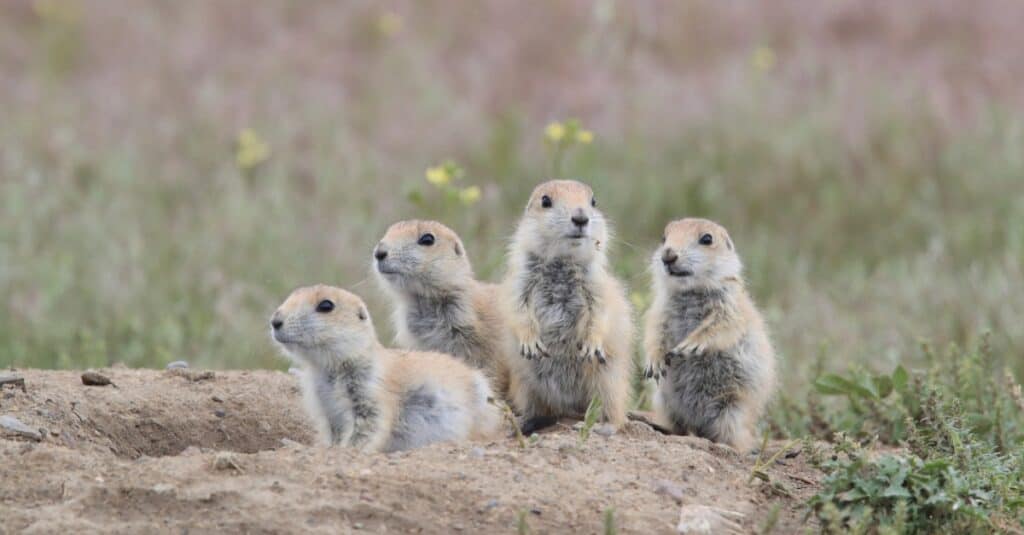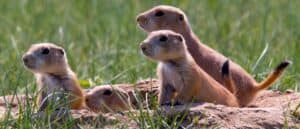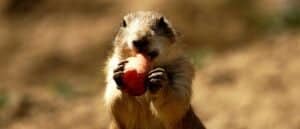- Pups kiss their mothers to derive comfort from them.
- The practice also enables them to identify one another.
When you think about it, prairie dogs have a lot of funny behaviors. They leap into the air, whistle, chatter, yip, and kiss. Perhaps you’ve seen a video clip of two prairie dogs putting their faces together and kissing. Biologists have studied this kissing behavior and have come to some surprising conclusions. Interestingly, a prairie dog kiss is more than just a sign of affection.
Continue reading to learn why prairie dogs kiss, how they live and what they do when danger is near.
Why Do Prairie Dogs Kiss?
Look closely and you’ll see that when prairie dogs kiss they are pushing their front teeth together. Of course, they are taking in the scent of the other prairie dog as well. While this kiss is used by these animals as a greeting, it’s also a way to make sure they are members of the same family. A kiss in the world of these small critters is the equivalent of saying someone’s name.
Adult prairie dogs kiss to identify one another. In addition, a baby or pup will kiss its mother for comfort to know she is nearby. This behavior is very common in a family of these small animals.

©Nick Fox/Shutterstock.com
Family Matters to Prairie Dogs
A family of prairie dogs is known as a coterie. A coterie can contain as many as 19 members. So, you can see why these animals have to kiss to keep track of all their family members! Normally, a coterie has one male and at least two or three females along with their young.
A prairie dog coterie lives in the same area as other prairie dog coteries. All of these families live relatively close to one another to form a colony or town. Welcome to prairie dog town!
Take a close look at the habits of this small mammal and you’ll discover a colony of prairie dogs is divided up into wards. Generally, each coterie remains in its ward. One ward may be located just over a small ridge or hill from another. The families in each ward can see and hear each other but don’t visit. They may even share a food source in the area. All of the coteries enjoy the safety of living near each other while rarely interacting.
Is Kissing Always a Positive Behavior?
No. A kiss between prairie dogs can be a way of finding an intruder. Male prairie dogs are extremely territorial. With just one male in a coterie, that male wants to protect not only the females and young in his family but his burrow as well. If one male tries to invade another male’s coterie, it can quickly turn into a vicious encounter.
Female prairie dogs sometimes try to enter the coterie of another female to kill her young. Why does this happen? One of the reasons a female kills another’s young is to remove future competition for food in the habitat. Also, by killing the young, it can cause a shift in territory allowing more space for the invading female and her young.
These animals are always looking for better ways to ensure their survival and the survival of their young.
How Do Prairie Dogs Defend Their Territory?
A fight for territory between males can cause minor or even serious injury. These mammals have very sharp teeth and claws. A fight involves two prairie dogs chasing each other, rolling on the ground, and biting one another. This happens until one of the males moves off showing the other one is dominant.
Two fighting prairie dogs make a lot of growling and snarling noises. This attracts the attention of other males in the area. So, in the process of fighting one male, the dominant male is showing others in the area that he is the strongest. This may discourage other males from challenging him in the future.
Of course, some males do lose their territory to stronger males in the course of a fight. As a consequence, the weaker male is forced to find another place to live and establish another family. Strength and the ability to defend a territory are essential for male prairie dogs.
How Big is the Territory of a Prairie Dog?
A single coterie claims approximately one acre of territory. But keep in mind some prairie dog towns can stretch over hundreds of acres of land. In Texas, biologists report a prairie dog town spread out over 25,000 square miles!

©Frank Fichtmueller/Shutterstock.com
How Do Prairie Dogs Defend Themselves Against Predators?
These small animals are always on alert. There’s a good reason for that. Snakes, foxes, coyotes, eagles, and badgers are all on their long list of predators. Though they are not large enough to battle successfully with these predators, prairie dogs do have some ways to defend themselves.
A prairie dog’s sight and hearing are both excellent. This helps them to remain on alert to predators in the area. When one prairie dog sees or hears danger, it begins to alert others in its coterie and the colony at large, through a series of chirps and barks. This animal stands on its hind legs chirping and barking loudly into the air. Other prairie dogs start to echo the warning through the territories. This gives the prairie dogs time to take cover in their underground burrows.
When the predator has moved out of the area or the danger has disappeared, these animals jump around and make a yipping sound to tell others in the area that it’s safe. This cooperative behavior of these animals may not always save every life, but it gives most of them a real chance to avoid danger.
Up Next…
Keep reading these posts for more incredible information about key animal facts.
- 10 Incredible Prairie Dog Facts: Where do they live? What do they eat? How do they communicate? Discover the answers to these questions and more right here.
- What Do Prairie Dogs Eat? Are they partial to a few insects? Or are they strictly herbivorous? Read all about their dietary habits in this post.
- Where Do Prairie Dogs Live? Find out how surprisingly organised these gregarious rodents are.
The photo featured at the top of this post is © iStock.com/Jon Marshall
FAQs (Frequently Asked Questions)
What is the habitat of a prairie dog?
Prairie dogs live in the grasslands and prairies of North America. Specifically, the habitat is a burrow featuring a series of tunnels and ‘rooms.’ Each of the rooms serves a certain purpose. Some of them have food, others are meant for sleeping and there are rooms for females and their young. The entrances and exits of a burrow are usually located near mounds of dirt. These burrows can go as deep as 15 feet.
This animal is always digging, repairing, and adding to its elaborate burrow system.
Are prairie dogs Endangered?
There are some types of prairie dogs that are Endangered. The IUCN Red List of Threatened Species categorizes the Utah prairie dog and the Mexican prairie dog as Endangered.
The Gunnison’s prairie dog, the black-tailed prairie dog and the white-tailed prairie dog are all noted as Least Concern, but with decreasing populations.
What are some threats to the population of prairie dogs?
Habitat loss is one threat to them. Expanding farmland and construction of residential neighborhoods are taking land where prairie dogs make their homes. Also, these animals are poisoned by some farmers and ranchers because they are considered pests. They sometimes eat the seeds and vegetation growing on farms as well as dig up parts of crops.
Are prairie dogs aggressive or shy?
Prairie dogs are considered shy animals. Though they’re curious, they will disappear into their burrow if a human or a threatening animal comes too close.
An exception is males become aggressive when defending their territory and females are aggressive when defending their young. But this sort of aggression is common with many species of animals.
Prairie dogs that live in a zoo are likely to be bolder than ones living in the wild. Animals in a zoo become accustomed to zoo keepers feeding them, cleaning their exhibit, and moving around in their habitat. So, the animals are less frightened knowing they are safe and taken care of.
Are prairie dogs important to the ecosystem?
Yes! These animals play a critical part in the ecosystem. For one, prairie dogs are a source of food for many types of animals. Plus, the digging and burrowing activities of these animals aerates the soil to make way for the growth of more vegetation. Some other animals (that also play an important part in a successful ecosystem) take shelter in abandoned prairie dog burrows. These include snakes, burrowing owls, weasels, and ferrets just to name a few.
Do prairie dogs make good pets?
Take one look at the adorable face of this small mammal and you may think it would make the perfect pet. After all, it kind of looks like an extra-large gerbil. But, the truth is, they don’t make good pets. They are wild animals that want to burrow deep into the ground and live with many other prairie dogs in a family.
But, just because you can’t keep one as a pet doesn’t mean you can’t enjoy learning all about these busy little creatures.
Thank you for reading! Have some feedback for us? Contact the AZ Animals editorial team.






